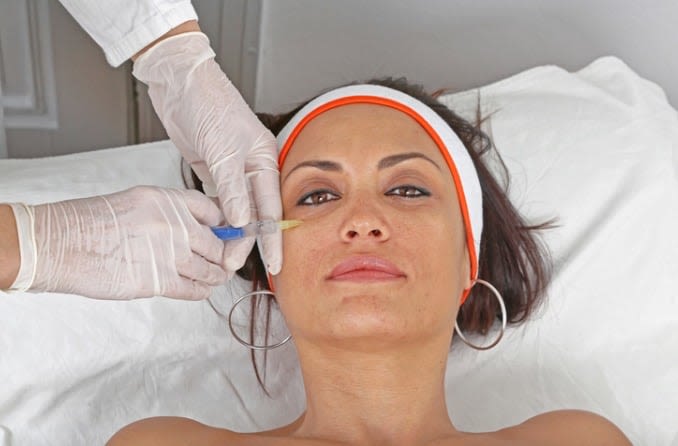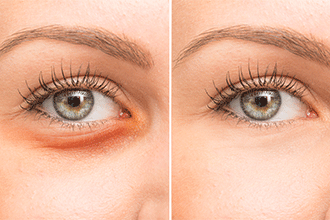Under eye filler: Cost, safety and what to expect

Tired of looking tired? Some patients who dislike the circles, lines or hollows under their eyes are turning to under-eye fillers to smooth their skin. Getting plenty of sleep, cutting back on salt and taking care of your skin can help prevent bags and dark circles under the eyes.
Plus, makeup or a colorful pair of glasses can camouflage (or distract the eye) from these common skin issues.
But if you’re still unhappy with the appearance of your lower eyelids, under-eye filler may provide a solution. This guide to under-eye filler should answer any questions you have if you’re considering this as a solution, including safety, cost and what to expect after the injections.
What is under-eye filler?
Under-eye filler is a targeted injection of hyaluronic acid in an area under the eye in order to minimize unwanted dark circles, hollows, lines or wrinkles. Dermatologists use various brands of under-eye fillers, including: Belotero, Juvederm Ultra, Radiesse, Restylane and Restylane Silk to treat tear trough deformity and other issues.
Under-eye fillers can be used anywhere around the eye where there’s an undesired contour, defect or line. For example, you can get:

Under eye fillers can be used to reduce the look of under eye hollowness, sunken tear troughs and fine lines.
Crow’s feet filler – Dermal filler may be used to soften the lines that fan out from the outside corners of your eyes that may deepen when you smile or laugh.
Tear trough filler – Filler may be used to smooth out the curved line under your eyes that starts at the inside corner of the eye and runs down toward the cheek.
Under-eye wrinkles filler – Filler may be used to erase or soften any other fine lines and wrinkles underneath the eyes. The skin underneath the eye is very thin and prone to wrinkles.
It’s important to have realistic expectations. Patients with thicker, smoother skin may have better results than those with thinner, more wrinkled skin under the eyes. It’s also important to note that fillers may reduce shadowing but can’t change the color of the skin under your eyes. A dermatologist can work with you to come up with a plan to address your desired outcome.
The procedure of injecting under-eye fillers typically takes only a few minutes. After the procedure, it may take time for bruising to fade, swelling to go down and filler to settle. It can take a few weeks to see the final results.
Tear trough filler
Tear trough filler may help to minimize the appearance of dark circles under the eyes that result from shadows being cast in the under-eye area. As mentioned, fillers can’t change the pigmentation of the skin, so they won’t work on all dark circles.
The “tear trough deformity” is a term used to describe a line or hollow running from the inside corner of the eye toward the cheek that can cast a shadow over the under-eye area. The tear trough deformity results from the normal anatomy of the area underneath the eyes, but some patients seek treatment because they feel it makes them look tired or gives their eyes a sunken appearance.
Under-eye filler: before and after photos
Want to see under-eye filler before-and-after photos to get an idea of the results? This may help you to make a decision about whether to get under-eye filler.
The best source for under-eye filler before-and-after photos is through your dermatologist. Ask your doctor if they have a selection of photos of previous patients who have received under-eye fillers so you can get a sense of your particular dermatologist’s capabilities and results.
Under-eye filler cost
How much is under-eye filler? The cost of under-eye filler varies based on the brand of filler, the amount of filler needed and the dermatologist’s pricing structure.
Under-eye filler is priced by the syringe. The average cost in the U.S. of a hyaluronic acid filler typically used under the eyes is about $652 per syringe, with most patients requiring multiple syringes, according to the American Society of Plastic Surgeons (ASPS).
In the UK, the cost for dermal fillers, including under-eye fillers, ranges anywhere from £200 to several hundred pounds.
Your total cost will depend on the total number of syringes needed.
How long do under-eye fillers last?
Hyaluronic acid under-eye fillers typically last between six months and a year before they need to be redone. The length of time fillers last depends in part on the brand of filler used.
It is typical for under-eye fillers to last about six months after the first time you get them, and then to last longer with additional treatments in the future.
Is under-eye filler safe?
While hyaluronic acid injections are approved by the U.S. Food and Drug Administration (FDA) for certain areas of the face, injections under the eyes are considered an “off-label” use. In the UK, injectable dermal fillers are considered by the European Medicines Agency (EMA) as medical devices and are less heavily regulated than in the U.S.
It’s important that under-eye fillers be injected properly and that they not be injected into the blood vessels. If that happens, the filler material could move into the blood vessels of the eye and cause blindness. For this reason, it’s important to have under-eye fillers injected only by a dermatologist or facial plastic surgeon who has a lot of experience with under-eye fillers.
There are some patients who should not get under-eye filler. For example, don’t get under-eye filler if you:
Have an allergy to a material in the filler
Have an infection near the injection site
Have very large eye bags
Have herniated fat pads under the eyes
It’s also important to avoid taking aspirin, non-steroidal anti-inflammatories, vitamin E and ginkgo biloba for at least five days before you get the under-eye filler injected. That can help to decrease the risk of bruising around the eyes after the procedure.
If you’re interested in getting under-eye fillers, ask your eye care provider for a referral to an experienced dermatologist or facial plastic surgeon who has experience with under-eye fillers. Your dermatologist can go over the pros, cons and risks of the procedure to help you decide if this procedure is right for you.
Ask a surgeon - Soft tissue fillers. The Aesthetic Society. Accessed March 2021.
Dermal fillers cost. American Society of Plastic Surgeons. Accessed March 2021.
Face and lip fillers (dermal fillers). NHS.uk. July 2019.
What to expect after lower eyelid fillers. Boston Eyelids. Accessed March 2021.
Nonsurgical rejuvenation of the eyelids with hyaluronic acid gel injections. Seminars in Plastic Surgery. February 2017.
Belotero or Restylane under the eye? The Aesthetic Society. Accessed March 2021.
Dermal fillers for the treatment of tear trough deformity: A review of anatomy, treatment techniques and their outcomes. Journal of Cutaneous and Aesthetic Surgery. October-December 2012.
Soft tissue fillers for crow’s feet. American Society for Dermatologic Surgery. Accessed March 2021.
Dermal fillers are medical devices in the UK. BMJ. July 2009.
Page published on Tuesday, 17 May 2022






